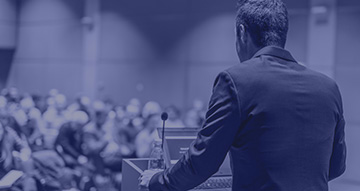Telling Stories, Wowing Audiences: The Rising Wave of Podcasting in India
By Dhruvank Vaidya, Head of Podcasts, Spotify India |Nov 01, 2021
What influences the audio industry and engages audiences? Listen to this podcast by Dhruvank Vaidya, Spotify India, to understand how podcasts are booming in India.
Telling Stories, Wowing Audiences: The Rising Wave of Podcasting in India
Dhruvank Vaidya, Head of Podcasts, Spotify India
From a single radio channel that broadcasted news bulletins to countless private channels and local frequencies, Indians have had a long association with the spoken word. Podcasting, the latest entrant in the audio industry, has countless takers—creators as well as consumers. Listen to Dhruvank Vaidya, Head of Podcasts, Spotify India, talk about how podcasts will become the go-to destination for all content needs.
TRANSCRIPT
Shruti Singhal: 0.03
Listening to this in 2021, chances are that you’ve heard about the podcast industry and listened to a show. If not, you’re here just in time, as more of us produce and consume audio content. COVID-19 perhaps played some part in this, but this boom can’t be all due to the pandemic. There’s also data to prove this. PricewaterhouseCoopers or PwC published its report in 2020, according to which, with 57.6 monthly listeners, India emerged as the third-largest podcast listening market in the world, after China and the US.
We’ll hear from Dhruvank Vaidya who heads podcasts at Spotify India about what Indians are listening to, some tips and tricks for aspiring podcasters, and how important it is to nurture the creator ecosystem.
Welcome, Dhruvank! Thanks for being on our podcast!
Dhruvank Vaidya: 0.58
It’s my pleasure, thanks a lot for having me on your show.
Shruti Singhal: 1.01
I’d like to begin by asking you...Podcasting has become a mainstay in today’s businesses just like content creation. People even go so far as to say that there are more podcast creators than listeners. What are your thoughts?
Dhruvank Vaidya: 1.18
Podcasting is a relatively new medium, but if you look at audio and audio storytelling, that has been there in our culture and our society for a very long time. I mean, radio is a classic example. What podcasting has done is made spoken word audio much more accessible to a large number of people. In the last five years that podcasting has grown in India, we’ve seen it reach across different parts of the country. It is relatively new, but you’d be surprised with the kind of reach podcasting now has. And, given that it’s an audio-only medium and it’s much easier to create in this, the kind of topics that [are] covered is also phenomenal. So yes, you will find a huge range of topics that are covered through podcasting; and also, the listener base is massive and growing. Gen Z and millennials have taken to podcasting much earlier than others, but I’m sure others will catch up as well.
Shruti Singhal: 2.32
Right, it’s the kind of thing you do when you’re driving, going for a walk, or while doing chores around the house.
Dhruvank Vaidya: 2.39
Correct. It’s very important to build podcast listening into your daily routine. And as you said, these are some of the times of the day when the hands are busy but the mind is free, which is where we see most of podcast listening, happening. While some of these things are true, what we are also seeing is that for people who are working, let’s say in shops or a taxi driver or an Uber driver, for them, it’s very hard to watch video while they’re kind of doing their work, but they can continue listening. Which is the beauty of the audio medium.
The other big thing about that works in favour of audio is that it’s a very immersive medium. When you are listening to it with your headphones on, it’s as if you were having a one-on-one conversation with the story. And it also helps learning; and that is one big thing that we are seeing that people are using podcasts to learn, to improve their selves, to gain knowledge and that is one massive use-case that we are seeing.
Shruti Singhal: 3.46
I love what you said about podcasts being immersive because listening to a podcast kind of quietens the mind, but at the same time, it helps direct all your thinking towards a more compact sort of direction.
Dhruvank Vaidya: 4.00
Correct. Now if you see with social media and short video apps, the attention span that we have has reduced dramatically. I see that in myself, like I used to read a lot about 20 years back, but today, I find it really hard to even read 10 pages at a stretch. But when you are listening to a podcast, let’s say I listen to it when I’m walking, I can listen to something with attention for that one hour. Suddenly, now you have a time-period and a medium through which you can do deep listening, deep thinking, and just absorb something much better.
Shruti Singhal: 4.37
Sure, yes, that makes sense.
Dhruvank Vaidya: 4.41
Podcasting is growing as we speak. I’ll give you an example. Let’s say when [the] Internet started [for me], my default was text search. Very recently, I was talking to my friend’s son, and he looks at videos as his default search and go-to mechanism to answer any of the queries that he has. Audio and podcasting are going to become the default search in the next few years. There is so much material out there. You just search for it, and you’ll find it. That is the space that we’re headed towards; that is the excitement; that is the brilliant part about being in audio right now as we are seeing an industry grow. So, I think yes, exciting times ahead.
Shruti Singhal: 5.27
Even with an increased adoption, podcasts seem to be under monetised when compared to other forms of media. How do you see the podcasting business in India and abroad transforming and affecting the future of paid listening, which is currently a small part of overall listenership?
Dhruvank Vaidya: 5.44
So, see, if you map the trajectory of digital businesses, across digital businesses, social media, publishing, you have to build an audience first. You have to build an engaged audience, and then monetisation follows. And we have seen this playing out across multiple companies and multiple sectors, and they have become large companies and large sectors today. I mean you look at social media, digital video, news publishing, across the board. So that is the same thing that is happening in podcasting. Right now, we’re in the phase where we are building engaged listeners; we’re trying to figure [out] what are some of the genres and kinds of content that work with listeners, and monetisation will follow.
If you look at [the] US and Europe, we already see monetisation, like ad-based monetisation is very prevalent there. Recently, Spotify launched a paid podcast service. So, you can actually put your podcast behind a paywall and charge your subscribers. It’s like something that Patreon is doing for newsletters for example. Tipping may also work, where if you like a creator, you may just leave a tip, so, micro-payments. Of course, there is brand-led monetisation, there’s sponsorships, there is branded content, so all those are the traditional and known and very well-established monetisation formats. So, monetisation models are evolving, everything will open up; it is just a matter of time. In the next two years, we will be having a very different conversation on monetisation.
Shruti Singhal: 7.28
True, true, really exciting times ahead and there’s so much potential like you said.
Dhruvank Vaidya: 7.32
Yes.
Shruti Singhal: 7.33
While podcasts by themselves are free for listeners to subscribe and listen to, platforms like Spotify have a ‘freemium’ model. In this regard, could you talk about the various ways of monetising podcasts, and how these are different from those for music?
Dhruvank Vaidya: 7.50
Freemium model is for the app, where you can listen to music and podcasts with ads. Or, you can pay a small subscription fee and listen to it without ads. Where podcasts differ from music: see, music is already created outside, and the platform just kind of brings it to the listener. Whereas podcasts are created afresh. So, you’re able to, let’s say, weave in your brand very closely into the podcast content. So, branded content becomes very easy, [and] host-read ads—the host can actually talk about your product or your service, and kind of spend time talking about it; and again, the medium has engaged listeners. So, whatever listenership the host has, those listeners are going to listen to what the host is saying. So, that becomes a very powerful ad unit. These are some of the ways in which podcasting can be very different from music when it comes to monetisation.
Shruti Singhal: 8.50
Right. Could you talk a bit about audiences and their preferences? Do you think some formats are more listener-friendly than others?
Dhruvank Vaidya: 9.00
So, in India, what we are seeing is that our podcast listening audience skews young. Our average age is around 20-21 years, and Gen Z listeners are our biggest cohort. I think what is happening is that Gen Z is very open and they’re very friendly to try out new formats, and they’ve kind of caught on to podcasting very easily. Having said that, there are older listeners as well, and we are seeing that growing in mature markets like the US and Europe. The average age [there] is much older than in India, and I’m sure as podcasting grows much more in the country, we’ll see that average age move a little.
The two big things that people consume podcasts for is: self-improvement or entertainment. We have so much content on management and across a wide range of topics. So, there is management; there’s leadership; there are interviews with top CEOs of the world; and everything is available for free for you. Which means, there is no other place where you can access this kind of content today. So that is one big powerful space for content.
Self-improvement also includes motivation, inspiration, meditation, spirituality. Because all these are areas where you go deeper within yourself, or you are with yourself when you are meditating.
And the next is entertainment. We have one huge share of listeners who prefer fiction. Whereas, if you look at the US and Europe, the proportion of fiction in podcast listenership is very low. But India is different in that sense, and we see a lot of crime thrillers, romance, and storytelling. We recently released a show called Virus 2062. It’s based on an adaptation of a Chilean Spotify original, and it’s a sci-fi thriller. It’s a 10-episode show and it’s fantastic. The story weaves beautifully, and we’re seeing huge traction for it.
Shruti Singhal: 11.05
I was actually going to ask you about that series and its bingeable format... Where the ten episodes of 20 or so minutes were released in one go, to sort of promote listeners to listen to them all, basically binge-listen to them. How do you think the sensibilities of video have come to inform the audio industry?
Dhruvank Vaidya: 11.27
Yeah, so I would actually zoom out a little and say look, there is a certain pattern in which Indians consume entertainment. And if you study it deeply, that pattern has not changed over time. What may have changed is the formats in which that entertainment is served. If you step back 50, 60, 70 years, there used to be serialised fiction stories in magazines. So, every week, the new editions [of the magazine] come, there is a [new] chapter of the story, and we used to read a lot of that. That then moved when it came to TV, and it became your daily soaps. And now, in podcasting, we’re seeing the same thing. There were radio dramas earlier on, and now that’s what we are seeing in podcasting, where you are seeing serialised fiction, episodic crime stories, you name it. So, I think the entertainment culture and patterns are similar; it is just that how you serve it in different mediums [has changed].
What definitely changes is that as generations progress, you’re exposed to much more stuff around, like you’re exposed to global entertainment, you’re exposed to different formats, your milieus, and your social cues are different; so, the setting in which you have to put the story would change. But otherwise, it’s broadly similar. So, to that extent, there’s a lot to learn from the past to inform what kind of content we should do for our audiences right now.
Shruti Singhal: 13.03
Right, so you’re saying it’s kind of like the natural progression of things.
Dhruvank Vaidya: 13.07
Yes, yes, absolutely.
Shruti Singhal: 13.10
Right.
Dhruvank Vaidya: 13:12
Audio is such a natural medium. I mean it is like one person talking to the other. I mean oral storytelling goes back like eons, and that oral form of propagating stories and tales comes very naturally to us, which is where podcasting is kind of finding that traction among people now.
Shruti Singhal: 13.33
True. Another thing is democratisation of voice—the fact that anyone anywhere can start a podcast, express their voice, and gain a listenership. At the same time, we see that platforms prefer to go with celebrities and actors, instead of promoting newer voices. Do you see this changing?
Dhruvank Vaidya: 13.53
Actually, we have a very different approach to the creator ecosystem. We want more and more creators to come and create podcasts on our platform. We have a tool called Anchor, which allows you to create your own podcast and upload it on Spotify, and a whole bunch of other platforms. So, it’s like a self-creation tool. And, we also believe that every creator who wants to create a podcast should be able to do it for free. So, we are democratising content massively with this.
Also, we launched a programme called AmplifiHer. This was to promote women creators in audio across music or podcasts, because we strongly believe that by building the ecosystem around creators and audiences and monetisation, is the only way to kind of make this massive industry.
Yes, we do work with a lot of actors, and we would continue to work with them. But the whole creator ecosystem is also equally important for us.
Shruti Singhal: 15.00
Speaking of the creator ecosystem, could you talk a bit about data? What, in your opinion, is the magic number when it comes to listener analytics?
Dhruvank Vaidya: 15.09
If you are a creator, you want to find your audience. For every kind of creator, their goal should be to keep growing their audience. If you look at the film industry, there are very few stars who will reach, let’s say millions of fans. But just because let’s say somebody on YouTube has 10,000 subscribers, that is a huge audience for them. My 10 years old son recently created a YouTube channel. He does gaming videos there. And he got so excited when he got 20 subscribers, because he has found his audience. So, for him, those 20 subscribers are very important. One of his videos hit 2,000 views, and every day he used to count and tell us, ‘Papa, it is 1,923 today,’ and in the evening, he will say it has become like 38. So, see, it is about building an audience for the creator.
And that journey is what is beautiful, it is enriching, and it is very encouraging. So, I think that’s what we try to do is that for each creator; we help them to find and grow their audience.
Shruti Singhal: 16.26
So, I think you’re saying don’t let the numbers overwhelm you. Create your product and find your audience.
Dhruvank Vaidya: 16.34
Absolutely, you have to kind of continue to create because creating a regular podcast is a dedicated effort. To create something week on week requires that discipline, but if you stick to it, you will find your audience.
Shruti Singhal: 16.52
Right. Speaking of audiences, could you talk about increased programming in regional languages?
Dhruvank Vaidya: 16.59
As podcasting grows in the country, we will find more and more people across Indian languages creating podcasts. Today, on Anchor, we see people creating podcasts in at least 13 Indian languages. I think this is only growing. India lives in its languages. Indians consume entertainment in their mother tongue, in their local languages. I’m Gujarati, my wife is Tulu; the kids don’t speak either of the languages, but they understand them. So, if they can listen to something in these languages, they’ll be able to appreciate it. So, that is only going to grow. I mean, we will see lots and lots of content coming in regional languages.
Shruti Singhal: 17.43
Right. With the rise of text-to-speech and allied tools (like Talkia, for instance.), how do you see Artificial Intelligence and Machine Learning integrating with podcasting?
Dhruvank Vaidya: 17.54
I think this is a good thing to happen, because if you look at text on the Internet, we have like millions of websites, and we have so many webpages, so many bloggers and newspapers publish so many articles every day. In an ideal world, all of this should be converted to audio. And why not? I think text-to-speech is a brilliant tool to kind of convert all the text that we have in the world into audio content. So, more power to more such tools and platforms.
Shruti Singhal: 18.29
Right. A few quick questions now.
What are five of your current favourite podcasts?
Dhruvank Vaidya: 18.35
So, I listen to a lot of podcasts, right? But my current five are: one is Virus 2062. It’s a brilliant story and I think everyone should listen to it.
The next is a show called The Knowledge Project, by a gentleman called Shane Parrish, where he interviews people. So, his thought is that we should not reinvent the wheel, but we should learn from people who have already figured things out; and it’s a brilliant show.
The next one is called Fact of the Matter. It’s a new show, done by these two gentlemen who are quizzers; so, they each take one topic every week and go into details, trivia, back stories, history. They did one episode on Afghanistan; they did something on [the] Olympics; lesser-known facts about the Olympics. Brilliant stuff, very entertaining and very informative as well.
Next one is called Jaipur Bytes. It’s a podcast by the Jaipur Lit Fest, where they talk to authors and writers and eminent thinkers and personalities. I’ve been to JLF several times and I just love the vibe.
I also want to mention the fifth one is a show called Urdunama, done by this lady called Fabeha Syed, where she picks Urdu terms and words and explains them in detail, talks about what different shayars (poets), how they have treated this word, let’s say tanhayee (the state of being alone), and just gives you kind of a beautiful context around the world through stories, poetry, shayari (poetry), music, etc.
As you see with podcasts, there is such an eclectic mix of stuff that you can listen to. It’s just a matter of finding them.
Shruti Singhal: 20.21
You’ve given so many shows now, to add to the library. Five tips for newbie podcasters?
Dhruvank Vaidya: 20.30
First is, find the topic that you’re comfortable talking about [and] stick to the topic. I think being consistent and on-topic is very important for you to build the audience.
Second, use DIY (Do-It-Yourself) tools. They’re very easily available. If possible, get a good mic. But otherwise, I think it’s very easy to start. Don’t worry about: will I get a guest, what do I talk next week, et cetera, et cetera. That flow will come. I think once you start, it’s important to start the creation process.
Third is, promote yourself. Use your social media handles to talk about your podcasts, be kind of open, be out there, and make your podcasts as widely available as possible because you need to build an audience.
Four, listen to your audience, take feedback, and keep improving. You may have started with one thought in mind, but as you go along, you will get feedback, and then you should be open to kind of modify your show according to that.
And finally, I think you’re not alone in this journey. There are lots of podcasters in the country, so reach out, ask for inputs, ask for help, participate in podcasting events that happen, learn from others. It’s a beautiful journey, so it’s never too late to start.
Shruti Singhal: 21.50
Right. That’s beautiful. So, while it’s important to learn how to do something, it’s equally, if not more, useful to know what not to do. So, what five things should a podcaster not do?
Dhruvank Vaidya: 22.05
I think the first thing is to not get overwhelmed. Podcasting is not that complicated. Keep it simple, keep it easy, find your flow, and go with the flow. Second is, don’t take your audience for granted; what the audience is doing is building a personal relationship. So, just make sure you respect that. In terms of formats, I think it’s important to stick to one format. Next is, don’t break the creation flow; if you’ve told your audience you’ll create every week, then do upload an episode every week.
Shruti Singhal: 22.38
Thank you so much for doing this for us. It was amazing to listen to you.
Dhruvank Vaidya: 22.42
Great, thanks a lot for having me. It was lovely talking to you.
Shruti Singhal: 22.46
So, there you have it. Listen to podcasts if you don’t already. Like Dhruvank said, you’ll be intrigued, entertained, and even better informed. And if you’ve been sitting on an idea, get scripting, recording, and editing. With the audio industry in the country growing, podcast creation and consumption will only get easier, and help build an ecosystem that is diverse, inclusive, engaging, and maybe even profitable.
Thanks for tuning in. Take care and stay safe!

Dhruvank Vaidya, Head of Podcasts, Spotify India



